Can you tell a good meat rabbit from a poor quality one? This is an important skill to have in your arsenal when buying rabbits or choosing which offspring to keep. Learn what to look for so you can confidently select quality meat rabbit breeding stock.
New Zealand’s, Californians, Champagnes, and most meat rabbit breeds have commercial body type. A few breeds such as Americans and Beverens have a semi-arch or mandolin body shape. Read about the 5 body types of rabbits here: ARBA Proper Posing and Evaluation
I do a preliminary judging of my Champagne rabbits at 8 weeks, then pose them again at 12 weeks. At 12 weeks, you can get a pretty good idea of what they’ll look like as an adult. Don’t evaluate rabbits at 10 weeks or 14 weeks. They go through growth spurts at those ages which makes it hard to see their true type.
This post explains how evaluate a rabbit with commercial body type. Commercial rabbits have long wide loins and full hindquarters which translates into a solid meaty rabbit.
To evaluate a rabbit, it must be posed first …

Front legs are flat on the table and back feet should be in line with the knee joint.
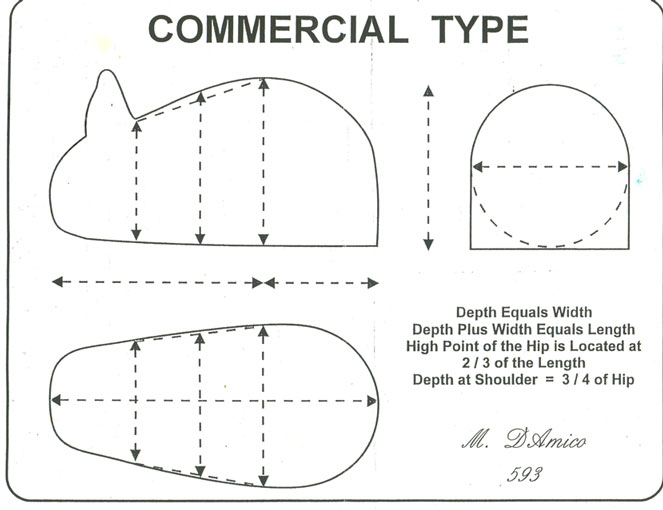
Mike D’Amico of Ohio
Judging a Meat Rabbit
Pose the rabbit
Place the rabbit on a padded surface such as a folded towel or carpet square. This will help it feel more secure. Stroke its head and ears firmly a couple times. The rabbit will naturally ball up and relax. Front toes should be under eyes and back toes in line with knees. Make sure the front legs are flat on the table from paw to elbow.
Topline
Most judges evaluate the topline first. The highest point of the back should be above the hip. If a rabbit peaks too early, they often have a chopped hindquarter. Chopped hindquarters drop off suddenly and feel flat and bony above the tail rather than rounded and full. This is a serious fault that is very hard to breed out. Keep an eye on your toplines and select rabbits that peak further back so you don’t inadvertently breed towards this fault. Don’t purchase breeding stock with chopped hindquarters.
Depth
Good depth (height from highest point of back to table) is very desirable for showing and meat. It means a longer loin. Many people over-pose their rabbits to give the illusion of more depth. Resist the urge to make rabbits look better than they really are by squishing their hindquarters to their head. If the back toes are in front of the knee joint, you can’t see the real depth of the rabbit.
Width
The best way to judge the width of a rabbit is to feel it. Pose the rabbit, then run your hand from the base of the neck to the tail. A quality meat rabbit will have a smooth rise and nice full hindquarter. The shoulders should have good width. The loin (space from shoulders to hips) should feel wide and firm. Picture half of a basketball – full and rounded in all directions. A poor quality rabbit has narrow shoulders leading to a thin loin.
Foundation
The underside or base of the rabbit is also important. The hind feet should be close to parallel and set well apart. When posed, feel how far apart the rabbit’s heels are. Ideally they should be 2-4″ apart. The chest and ribcage should be rounded. A thin peaked chest means that the rabbit is narrow underneath and the back feet are probably too close together (fault often described as undercut). If the back toes point outward, the rabbit is pinched. Rabbits with pinched hindquarters lack fullness in the thigh and are more likely to get sore hocks.
Here are some examples
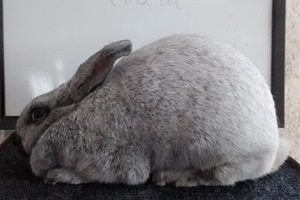
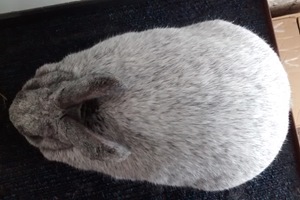
Excellent conformation.
Peaks right over hip. Nice depth & width. Round, full hindquarter.
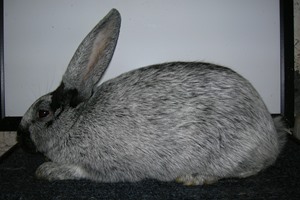
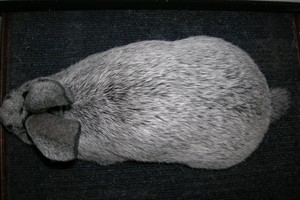
Long and low. No depth. Very little rise from shoulder. Body is narrow and thin. Pinched hindquarter.


Peaks too early with chopped hindquarter. Top-line peaks before hip. Note the flat hollow area above tail.
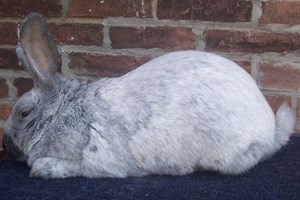
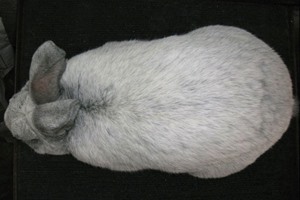
Long, low shoulder. Note low flat part of shoulder before the rise in the back. Semi-arch body shape.
Quality Meat Rabbit Breeding Stock
All rabbits have strong points and weaknesses. Purchase the best stock you can. When breeding, try to pair the weak traits of one rabbit with the strengths of the other. Keep the ideal in mind and only save offspring that are closer to your goals.
Growth rate is also important if you want to raise meat rabbits economically. Good meat lines give you more meat in less time on less feed. Some show rabbits take forever to grow and eat a ton, especially those with big bones (such as Flemish). Ask the breeder what their rabbits weigh at 8 weeks. Ideal growth rate is 5 pounds by 8-10 weeks. Learn more about Meat Rabbit Growth Rates.
Be sure to check potential breeders for malocclusion (bad teeth), split penis, wry tail, and good health before adding them to your breeding program. Always quarantine new rabbits for 30 days before adding them to your herd.
Hill Rise Rabbitry’s info on selecting quality stock:
Evaluating Adult Rabbits – posing and good body type
Evaluating Rabbit Health – inspecting for good health
Posing Commercial Breed Rabbits: ARBA Judge – Josh Humphries
More posts on judging quality meat rabbits:
Selecting Meat Rabbit Breeding Stock
Commercial Meat Rabbit Growth Rates
Keywords: commercial rabbit, fryer, judging, meat rabbit, show rabbit, pose rabbit, posing rabbit, meat pen
Related Posts:
- Meat Rabbit Pros & Con
- Breeding Meat Rabbits: From Pairing to Fryers
- Champagne d’Argent: The Color Changing Rabbit
- Raise Meat Rabbits: Quick Start Guide
Was this info helpful? Comment below with the strengths and weaknesses you observe in your rabbits after posing and evaluating them…


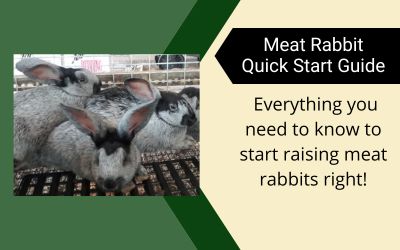
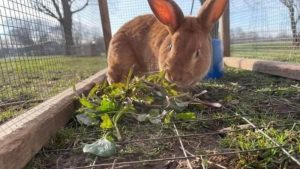


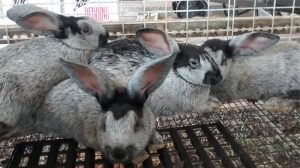
How do rabbits fair in colder climates? I live in Bangor, Maine and we get very cold in the winter. Do you have literature about how to best protect the rabbits in this situation?
Rabbits handle the cold fine as long as they are protected from wind and wet. In areas with severe winters, it is best to put their in cages/hutches in a barn, shed, or garage. You can read more about winter rabbit care in our Meat Rabbit Quick Start Guide: https://homesteadrabbits.com/raise-meat-rabbits/
As long as you keep them from getting wet they will be just fine.
Im looking for a few good meat rabbits for our small farm
If you are looking for rabbits, I invite you to check out our ‘Meat Rabbit Breeder List’. You can search by breed or state. Good luck! https://breeders.homesteadrabbits.com/
Where can I purchase rabbits already cleaned and frozen to ship here? I’m here in Tucson, Arizona. Thank You. I wanna be a customer.
Irene M.
We do not sell rabbit meat. You can check out our breeder directory to find a local breeder. Search by breed or state. Good luck! https://breeders.homesteadrabbits.com/
Wow thank you so much. I have been so overwhelmed with all the reading I’ve been doing to start breeding and raising my own meat rabbits and this is amazing. More simple and easy to understand. I’m surely saving .
I’m glad you found it helpful!
thank you so much for all of this info. I have been raising rabbits for about a year by mostly trial and error. Reading and watching YouTube and doing my best. I really appreciate the time you’ve put in to gather this info.
thanks again
Karen
Carpenter WY
I really appreciate your kind words! This informational website is a labor of love in hopes of helping others raise meat rabbits.